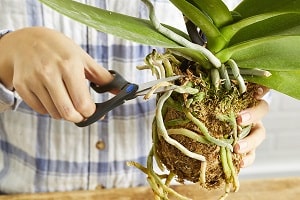Orchids need nutrients and nourishment for healthy growth and development. The only way for the Orchid plants to get these nutrients and nourishment is through absorption of water. When nutrients are dissolved in water, the Orchids will be healthy and well-developed. On the other hand, how can these Orchid plants absorb the water in order to be fully nourished, especially if the roots prefer to be dry most of the time? To understand how this happens, know what the experts say:
Orchids are epiphytes
Because Orchids are epiphytes, they grow by clinging to trees and rocks so that the roots can absorb the air, water, and nutrients from its surroundings. Some roots dangle on the trees and spread over the surfaces of branches to collect water drops. Some roots that are crawling on the ground absorb nutrients from chemicals brought by decayed leaves. This is how Orchids grow in the tropical regions and in the wild. If you are growing Orchids at home, the best way for the plants to grow healthier is to mimic this environment. You can help your Orchid plants absorb water and the nutrients they need by feeding them fertilizers regularly.
Orchids have velamen
Velamens are the spongy multiple epidermis of the Orchids located in the roots. They are the outer layer of empty cells located in the roots of Orchid plants. Most epiphytic plants have velamens. Velamens allow the Orchid plants to capture and absorb water. These velamens assist the plant in absorbing water. When Orchid plants are healthy and nourished, the velamen appears silvery-white in round and plump shape. Once it absorbs water, the silvery-white color turns into green because water reveals the color of the plant. After water is absorbed, its color returns to white while its tip remains greenish or reddish.
Orchids have aerial roots
Naturally, the aerial roots of the Orchids serve different purposes and functions. Aside from holding the plant in place, roots also anchor the plant on trees. The tacky substance in the roots help the plants cling to the tree and enjoy the aerial location. These aerial roots also obtain moisture in the air and nutrients from the ground. Inside the aerial roots are pipes or xylem. These pipes are the interconnected small capillary tubes that transport the absorbed water all the way from the roots to the leaves, spikes, and flowers. The movement of water through the plant is the transpiration. It does not only provide nourishment to the plant but also help cool down the plant. As the root absorbs water and distributes it to the entire plant, it also absorbs nutrients and nourishes the plant. For homegrown Orchids that require the same nutrition in order to grow and reach optimum health, fertilizer or plant food should be dissolved in water first. Orchids’ aerial roots can only absorb such nutrients from plant food if they are dissolved in water. In addition to that, is advised that Orchid plants should be watered first, at least a few amount of water, before giving the dissolved fertilizer solution to help roots absorb the nutrients better.
How to Care for Orchid Roots to Ensure Proper Absorption of Water?
Low humidity indoors or outdoors may affect the air roots of the Orchids. They will turn yellow and shriveled because of dehydration. If you see this signs, you can help your plants by cutting away the shriveled roots. However, you can only do this after the blooms dropped off. It is never helpful to cut affected roots while the plant is blooming. You have to wait the blooming stage to end before you can cut and trim the roots.
In caring for the roots, there are several things that you have to avoid. One of those is overwatering. Overwatering is always the main reason for the common diseases and problems of any Orchid plants. Although water is essential in growing orchids, too much of it may cause its health to drop down and kill it. The right amount of water given at the right time, including the plant food on schedule, is the best way to help its roots absorb the needed water and nutrients. On the other hand, under watering should also be avoided. You can help the roots function well accordingly by supplying enough water. Proper watering aims to provide the needed health and growth.
In addition to water and plant food, light and humidity are also essential to the health of the plants. Make sure that the plant gets enough light even if they are kept indoors. The desired humidity should also be maintained. If humidity is low, you can increase it by adding humidity tray. If humidity is high, reduce watering.
Common mistakes can be avoided if you want to take care of your Orchid plants. By ensuring that the roots are healthy and without fungal and bacterial infections, you can also ensure that they will function better in absorbing water and nutrients. It can be difficult to grow Orchids if you do not know what to do, but once you mastered the techniques, growing orchids at home is easier and rewarding. However, it can be easier to kill your Orchid plants than to grow one if you do not know and understand what they need to grow, develop, and bloom. Fortunately, you have the guidance and tips on how to grow different kinds of Orchids in your home or office spaces, and you can start that by learning how Orchids absorb water.
